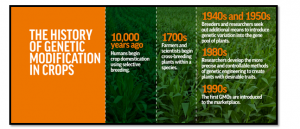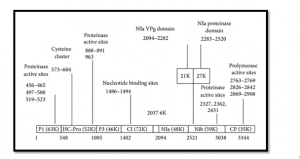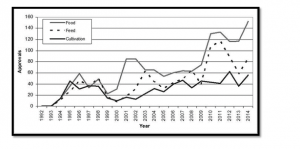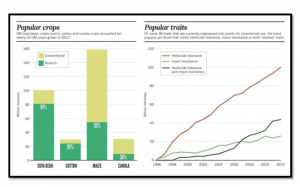GENETIC MODIFIED FOOD
Genetic modified food (GM), also known as genetically modified food or genetically engineered food are basically food that is prepared from organisms, plants or animals, whose DNA have been modified in a specific manner by employing genetic engineering.
The commercial production and sale have been popularized since the mid-1990s. In the year of 1994, Calgene introduced to the world its first product, the FlavrSavr, a tomato with delayed ripening. The product was unsuccessful, however it kick started the trend. Nowadays most genetic modified foods are primarily cash crops such as canola, corn and soybean. They have been modified to retain more nutrients and increase their resistance to herbicides and pathogens.
2. History of genetic modified food
Genetic food is now an active trend and has gained quite a lot of popularity across the globe. However, it is important to keep the history of genetic modification of organisms in mind when examining them. In this assignment, primarily the history of genetically engineered food would be closely looked at.
Genetic manipulation directly or indirectly controlled by humans began as early as 10,500 BC to 10,100 BC, as per Halewoodet al. (2018). During time it was extremely limited and only constituted of artificial selection during their domestication of plants and animals. However, true genetic modification came around much later. The modern genetic modification techniques are preceded by a process known as selective breeding. In this process, only the favored traits are left while the ones not preferred are dismissed. This is done by modifying the genes as they are the ones responsible for proving traits to the organism.
Genetic modified food can be seen as a newer and more modernized version of food alteration, whose previous iterations have been mutation breeding and selective breeding. Compared to the older methods, the new and updated process of genetically modifying food provides much greater control to the engineers concerning the traits and new traits can also be introduced in the foods.
In the year of 1935, a radical discovery took place that altered the science of genetics and genetic engineering. According to Ouobaet et al. (2019), NikolaevitchBelozersky, a Russian scientist discovered DNA by isolating a pure strand. Recombinant DNA or DNA, which is DNA prepared by man was created some years later in 1973. The idea originally came to a student of Stanford University Medical School. The idea was impressed upon and moved forward by Professor Herbert Boyer along with a number of his colleagues, who were biologists. In the year 1982, the FDA approved the first genetically modified organism. It was called the humulin, insulin created modifying the E. Colibacteria. 10 years later the first genetic modified food came to the market for the masses, FlavrSavr, as mentioned above. It was a tomato whose ripening has been delayed, thus increasing its lifespan.
At the onset of the 21st century, the general market of the world started to accept and embrace the genetically engineered food products. Genetically modified seeds were planted over 100 million acres of cultivation fields worldwide. Since then the demand for these products have grown exponentially and now they are consumed by more people across the world than ever before.

Figure 1: History of genetic modified food
(Source: Lima et al. 2017)
GM crops take entry in Britain as animal feed and there is lack of commercial growing across UK. However, experimental trials regarding GM potatoes and wheat appear in recent years. Large quantities regarding GM soya and maize are involved in import across Europe. European Union has decided to permit GM feed that involve trace crops level. Waitrose continues in requiring non products of GM especially for poultry and egg. In year 2013, Tesco has announced that they will not require any poultry to produce GM product for free. Apart from this, Advisory Committee upon Releases to Environment (ACRE) is responsible in providing significant advices to UK government associated with GM foods (Lima et al. 2017). In the year 2011, UK coalition government release guidelines for using GM foods and add these policies in the DERFA website (Barbour et al. 2016).
4. Advantages and disadvantages of GM foods
| Advantages | Disadvantages |
| They raise agricultural productivity and reduce needs regarding pesticides. Hence, they improve production and increases income of farmer. For example GM apples- Malus X Domestica | Production of GM foods imposes serious risks to ecosystem, such as it can disrupt biodiversity that may influence negative effects on gene flow. |
| They show dramatically enhanced yields and can be produced within small land region. | They are biologically altered that may pose adverse implications to human health, such as allergy (Barbour et al. 2016). |
| It minimizes use of pesticide as well as insecticide especially during farming that is great aspect for betterment of food supply | Excessive production of GM foods renders ineffective over time since pests coming from it produces toxins. |
Table 1: Advantages versus disadvantages of GM foods
(Source: Lima et al. 2017)
5. Properties and compositions
There are several examples of genetic modified food in the market today. In the UK corns are one of the most produced GM foods. These products are heavily consumed by the people of the world. In fact, it would not be false to say a significant portion of the consumers may not even be aware that the products they are consuming are genetically modified. This is because there are very few to absolutely no difference apparent in the appearance of the products. The most common genetically engineered food products are:
Hawaiian Papaya
Hawaii experienced a problem when the majority of the papaya produced in the country was being damaged due to a disease caused by the ring spot virus or PRSV. Prominent mosaic patterns appear on the leaf lamina and the upper part of the trunk. The country decided to genetically modify the papayas to combat this problem. As per Rapuanoet al. (2017) there were 3 primary aspects to this approach. They include coat protein mediated resistance, RNA interference mediated resistance and replicase gene mediated resistance.

Figure 2: Health benefits of Hawaiian Papaya
(Source: Lee et al. 2017)
According to Lee et al. (2017) transgenic papaya containing CP coat protein genes were developed and they were resistant to the ring spot virus. The gene transfer system of immature zygotic embryos using a plasmid construction was adopted for the process. RNA interference mediated resistance from the virus was developed by Waterhouse. Lastly, it has been noticed that replicase genes with mutations are capable of conferring virus resistance.

Figure 3: Map of the PRSV polyprotein
(Source: Barbour et al. 2016)
Corn
Corn has been genetically modified since several years with the goal of achieving higher production and more desirable traits. They also help in providing better resistance to the crops from viruses and bacteria. According to Zhang et al. (2016), Bt corn is a popular variant of corn that is genetically engineered and modified so that it is able to express one more protein, such as Delta endotoxins, from the Bacillus thuringiensis, a kind of bacteria.
The protein created from these bacteria also serves another purpose, as it seems to be poisonous to certain kinds of insects and pests. This provides the corn with an additional layer of protection. This helps in defeating the European corn borer which causes tremendous damage to crops annually, amounting to over a billion dollars. Traits aimed at warding off root worms or corn ear worms have also been implemented in recent years. They are also known to cause massive damage to crops every year.
Canola
Canola is yet another example of a heavily genetically modified crop across the globe. Canola was first genetically engineered by Monsanto to be more tolerant to glyphosate, according to McClements (2019), which is a primary ingredient used in Roundup, which is an extremely popular herbicide. Canola without the genetic modification would be unable to produce aromatic amino acids and would even die and cause huge losses.
The Roundup-ready Canola was created by modifying its genome. A couple of genes were added to its genome. The first gene is procured from the bacteria known as Agrobacterium strain CP4. On the other hand, the second gene is derived from the Ochrobactrumanthropistrain LBAA.
6. Genetic modification procedure
In a simple selection procedure, a particular plant or crop is chosen and the seeds of these plants are stored. These plants are labelled as superior who have all the desired traits (Delmond et al. 2018). This procedure is genetically heterogeneous and thus it is possible to produce the same species from the mother seeds. These seeds with superior traits are sowed for the production of next generation plants. Thus, repeating this procedure after some years plants are produced with only the superior gene and have the desired traits. As cited by Rubin et al. (2018), modern techniques of this simple selection are the marker-assisted selection. In this method, molecular analysis is done to identify the traits and the plants that are having the traits. This method helps to identify the superior category much faster than the traditional simple selection method.
7. Recent trends of genetic modified (GM) food
Genetically modified food is the application of genetic engineering in the foods and crops. In this recent era, it has become one of the most successful trends to mitigate the hunger issues of the world. In almost 26 countries across the world, GM foods are producing. As discussed in the study by Zhang et al. (2016), among them the USA, Brazil, and Argentina are top of them. These technologically modified foods are in trends due to the following reasons.
Firstly, genetic modification increases the level of nutrition in the foods. As people take food for providing nutrition in their body, highly nutritious food is the demand of the public. Besides, these foods are tastier than normal foods. Modification in the genes of the foods makes them tastier which is why people like to consume them. In most parts of the US, genetic foods are quite common and people prefer those foods that are healthier for the people. As mentioned in the study by Scott et al. (2016), the use of pesticides, fertilizer and natural resources such as water are less required for the production of GM foods. The overall expenditure of production reduces due to the saving in the above mentioned areas.
Thirdly, it grows faster than other food products. In this growing food demand from the people across the world, it is highly necessary that the food production rate become high. In this case, GM foods come as a suitable solution and it is a trend because its growing speed is much higher than normal production speed. Fourthly, these foods are used in the medical sectors for production of medicines which can cure diseases such as diabetes and many more. As depicted in the study by Pino et al. (2016), GM technology has the ability to add desirable traits into the foods such as potatoes are genetically modified in such a way that it causes less cancer producing elements at the time of frying.
GM apples (Malus X Domestica) are one of the most used GM foods. This food has traits such as antibiotic resistance capability, non-browning phenotype and many more. Canola is one of the famous GM foods and it is one of the special GM foods of Argentina. The scientific name of this food is Brassica napus. It is capable of providing protection from bacteria and it is required for glufosinate herbicide restoration and many more purposes (McFadden and Lusk, 2016). There are other GM foods such as Beans (Phaseolus vulgaris); Maize (Zea mays L.), GM potatoes, wheats and many more that have been used extensively in market of UK. Most of these food products have antibacterial capacity, fertility restoration, visual marker and many more.
Gene editing is considered as one of the latest trends of genetic engineering to form GM foods. This technology is able to construct gene drives which can spread genetically modified foods across wide populations (McFadden and Lusk, 2016). This process is much faster than the inheritance procedure of GM food production and country wise it has several rules and regulations for the usage of this technology.

Figure 4: GM approvals from 1992 to 2014
(Source: McFadden and Lusk, 2016)
8. Use of GM foods in different sectors
In terms of ergonomic benefits, GM foods are irreplaceable as it is responsible for producing huge quantities of foods across the world. It needs less amount of land for production of food products (Alavidoost et al. 2017). Using GM foods technology almost 138 million tons soya, 8 million tons Canola, 274 million tons of corn has been produced which give a huge agronomic benefit. Besides, it has economic benefits as the total production cost is less compared to other foods. It is also effective as it contains excess nutritious elements which keep a person always from diseases. According to Sattarzadeh et al. (2018), most of the GM foods contain bacterial resistance capability which keeps the diseases away. It is changing the food processing by introducing cost-effective and high productive ways which are highly needed to meet the demands for the food items.
Despite of using GM products as animal foods, there are many experiments going on regarding the development of GM food products in UK. The cardinal experimental GM food products are Camila Sativa (false flax), GM potatoes, wheat and many more (Sattarzadeh et al. (2018). It is expected that in the coming 5 years UK will be able to use GM food rapidly in the market.

Figure 5: Rise of GM foods in different sector of UK
(Source: Mahdi and Zin, 2018)
9. Social concerns of GM foods
The GM foods are in the trends due to some bad impacts on human health and many countries such as France, Russia, Germany and many countries have prohibited these GM foods. As per the recent trend in GM foods, it has been seen that these foods can cause allergies in the human body and thus these products should not be consumed by everyone. Thus, the recent trends suggest that before consuming genetic foods, suggestions from doctors are necessary (Royzman et al. 2017). In the recent debate on the usage of GM foods, it has come out that these foods are becoming harmful in many cases due to genetic modification.
The highlighted social concern of GM food is that it can contain toxic elements at the time of genetic change. Major health issues have been seen in the human body due to the constant consumption of genetic foods. These health issues are soya allergies, growth issues, early deliveries, infertility and many more.
In the UK there are no much strong evidences against the GM foods. It has been seen that the characteristics and behaviour of GM foods are different and cannot be generalized. As discussed by Jamaluddin et al. (2018), the health issues are happening in this country due to which the production of these foods is banned. However, in some countries such as US, Canada and much more no such evidence has been found which demands the prohibition of these foods. Thus, in recent trends, consumption of genetic foods has become a choice for the government and for the people that live in the country.
GM labelling has become a strict rule in most of the countries. It has been decided that it is the right of the people to know what they are consuming and for that GM foods have to be labelled. This label should contain the information on what characteristics of the food material have changed or the traits that have been added to the food (Nawaz et al. 2019).
This label should include whether any other gene from other sources have been added to this product or not. However, in the case of normal food ‘GM-free’ labelling is not going to be supported. It is expected that in the label it’s mentioned that if any food is not suitable for any special health condition such as a GM food is not suitable for people who have diabetes or allergy issues. In more than 40 countries, such as, the US and many more have passed regulations for GM foods (Ghasemi et al. 2019).
It has been seen that GM foods are beneficial as it is cost-effective and has fast growth. However, in UK, there are social and health-related concerns related to these GM foods. Therefore some modification is imperative for incorporating GM foods in the whole world. Few recommendations are suggested which can be proved effective for improving the GM food procedure.
Firstly, the R&D sector regarding GM food should be improved and more investment is required in this sector. These innovation and research modifications can help in developing more human-friendly GM food that does not have toxic contents (Öz et al. 2018). Secondly, agricultural studies can be more popular as it will attract students to research on agricultural foods which can mitigate the negative effects related to it. Businessmen and investors should be more focused as proper utilization of this technology can completely resolve the hunger-related issues throughout the world.
Besides, these GM foods should be cultivated in more protected lands where the outer atmosphere cannot destroy the quality of the foods. As discussed by Chen et al. (2018), the weather condition, climate, and environmental effects should be analysed correctly to find out the reasons behind the toxic elements on the foods. No one can be forced to take GM food however; people should be encouraged to take GM foods which are harmful and beneficial for their health.
Based on the above study it has been found that GM foods have a mixed reaction in the market as some countries allow this food and some have prohibited this. It has been seen that GM foods carry extra nutrition, have less production cost, fast growth and many more benefits. Some of the most common GM foods have been identified as GM apples, papaya, beans, canola, corn and many more. In UK, soybean and corn are the most cultivated GM food products and other products are imported from countries such as the US, Canada and others.
It has been found that these foods also have negative impacts such as allergies or toxic chemicals and thus GM foods are banned in most of the countries. It has been discussed that there are many methods such as simple selection and many more are used for cultivation of GM food products.
Alavidoost, M.H., Zarandi, M.F., Tarimoradi, M. and Nemati, Y., 2017. Modified genetic algorithm for simple straight and U-shaped assembly line balancing with fuzzy processing times. Journal of intelligent manufacturing, 28(2), pp.313-336.
Barbour, M.A., Fortuna, M.A., Bascompte, J., Nicholson, J.R., Julkunen-Tiitto, R., Jules, E.S. and Crutsinger, G.M., 2016. Genetic specificity of a plant–insect food web: Implications for linking genetic variation to network complexity. Proceedings of the National Academy of Sciences, 113(8), pp.2128-2133.
Chen, Z., Chengjun, S., Zewei, L., Kunping, L., Xijian, Y., Haimin, Z., Yongxin, L. and Yixiang, D., 2018. Fiber optic biosensor for detection of genetically modified food based on catalytic hairpin assembly reaction and nanocomposites assisted signal amplification. Sensors and Actuators B: Chemical, 254, pp.956-965.
Delmond, A.R., McCluskey, J.J., Yormirzoev, M. and Rogova, M.A., 2018. Russian consumer willingness to pay for genetically modified food. Food Policy, 78, pp.91-100.
Devos, Y., Naegeli, H., Perry, J.N. and Waigmann, E., 2016. 90‐day rodent feeding studies on whole GM food/feed. EMBO reports, 17(7), pp.942-945.
Ghasemi, S., Ahmadvand, M., Karami, E. and Karami, A., 2019. Social Risk Perceptions of Genetically Modified Foods of Engineers in Training: Application of a Comprehensive Risk Model. Science and engineering ethics, pp.1-25.
Halewood, M., Chiurugwi, T., Sackville Hamilton, R., Kurtz, B., Marden, E., Welch, E., Michiels, F., Mozafari, J., Sabran, M., Patron, N. and Kersey, P., 2018. Plant genetic resources for food and agriculture: opportunities and challenges emerging from the science and information technology revolution. New Phytologist, 217(4), pp.1407-1419.
Jamaluddin, R.Z.A.R., Heng, L.Y., Tan, L.L. and Chong, K.F., 2018. A Biosensor for Genetic Modified Soybean DNA Determination via Adsorption of Anthraquinone‐2‐sulphonic Acid in Reduced Graphene Oxide. Electroanalysis, 30(2), pp.250-258.
Lähteenmäki-Uutela, A., Grmelová, N., Hénault-Ethier, L., Deschamps, M.H., Vandenberg, G.W., Zhao, A., Zhang, Y., Yang, B. and Nemane, V., 2017. Insects as food and feed: laws of the European Union, United States, Canada, Mexico, Australia, and China. European Food and Feed Law Review, pp.22-36.
Lee, J.H., Shin, D., Lee, B., Lee, H., Lee, I. and Jeong, D.W., 2017. Genetic diversity and antibiotic resistance of Enterococcus faecalis isolates from traditional Korean fermented soybean foods. J MicrobiolBiotechnol, 27(5), pp.916-924.
Lima, M.R., Santos, C.S. and Vasconcelos, M.W., 2017. The use of genetic engineering to improve the nutritional profile of traditional plant foods. Phytonutritional Improvement of Crops, pp.233-258.
Mahdi, A.F. and Zin, M.Z.M., 2018. Comparing Consumer’s Awareness, Attitudes and Perceptions towards Genetically Modified Foods (GMFs). Borneo International Journal eISSN 2636-9826, 1(1), pp.15-19.
McClements, D.J., 2019. Food Biotechnology: Sculpting Genes with Genetic Dunn, S.E., Vicini, J.L., Glenn, K.C., Fleischer, D.M. and Greenhawt, M.J., 2017. The allergenicity of genetically modified foods from genetically engineered crops: a narrative and systematic review. Annals of Allergy, Asthma & Immunology, 119(3), pp.214-222.
McFadden, B.R. and Lusk, J.L., 2016. What consumers don’t know about genetically modified food, and how that affects beliefs. The FASEB Journal, 30(9), pp.3091-3096.
Nawaz, M.A., Mesnage, R., Tsatsakis, A.M., Golokhvast, K.S., Yang, S.H., Antoniou, M.N. and Chung, G., 2019. Addressing concerns over the fate of DNA derived from genetically modified food in the human body: a review. Food and chemical toxicology, 124, pp.423-430.
Ouoba, L.I.I., Mbozo, A.B.V., Anyogu, A., Obioha, P.I., Lingani-Sawadogo, H., Sutherland, J.P., Jespersen, L. and Ghoddusi, H.B., 2019. Environmental heterogeneity of Staphylococcus species from alkaline fermented foods and associated toxins and antimicrobial resistance genetic elements. International journal of food microbiology, 311, p.108356.
Öz, B., Unsal, F. and Movassaghi, H., 2018. Consumer attitudes toward genetically modified food in the United States: Are Millennials different?. Journal of Transnational Management, 23(1), pp.3-21.
Pino, G., Amatulli, C., De Angelis, M. and Peluso, A.M., 2016. The influence of corporate social responsibility on consumers’ attitudes and intentions toward genetically modified foods: evidence from Italy. Journal of cleaner production, 112, pp.2861-2869.
Rapuano, K.M., Zieselman, A.L., Kelley, W.M., Sargent, J.D., Heatherton, T.F. and Gilbert-Diamond, D., 2017. Genetic risk for obesity predicts nucleus accumbens size and responsivity to real-world food cues. Proceedings of the National Academy of Sciences, 114(1), pp.160-165.
Royzman, E., Cusimano, C. and Leeman, R.F., 2017. What lies beneath? Fear vs. disgust as affective predictors of absolutist opposition to genetically modified food and other new technologies. Judgment and Decision Making, 12(5), p.466.
Rubin, E.L. and Sax, J.K., 2018. Administrative guidance and genetically modified food. Ariz. L. Rev., 60, p.539.
Sattarzadeh, A., Rahnama, H., Nikmard, M. and Ghareyazie, B., 2018. Detection of genetically modified food in digesta and organs of rats fed transgenic potato. J. Anim. Feed Sci, 27(2), pp.163-172.
Scott, S.E., Inbar, Y. and Rozin, P., 2016. Evidence for absolute moral opposition to genetically modified food in the United States. Perspectives on Psychological Science, 11(3), pp.315-324.
Zhang, C., Wohlhueter, R. and Zhang, H., 2016. Genetically modified foods: A critical review of their promise and problems. Food Science and Human Wellness, 5(3), pp.116-123.
Zhang, Y., Jing, L., Bai, Q., Shao, W., Feng, Y., Yin, S. and Zhang, M., 2018. Application of an integrated framework to examine Chinese consumers’ purchase intention toward genetically modified food. Food quality and preference, 65, pp.118-128.


